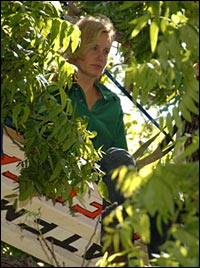The scene at South Central Farm would look familiar to anyone who’s ever attended a multi-day protest: there’s a makeshift kitchen to feed the masses, a small sound stage, a tent for banner-making. But the kitchen is preparing nopales quesadillas instead of vegan stew, the stage features a Norteño band replete with cowboy hats, and the banner-makers are nine-year-old Latina girls. Que Dios bendiga esta jardin, reads one sign: God bless this garden.
Situated among the warehouses, railroad tracks, and truck depots of industrial Los Angeles, South Central Farm is something of an oasis, and it’s become a vital food source for 350 low-income, mostly Latino families. Over the last few weeks, the threat of development has earned these 14 acres — which comprise the nation’s largest urban garden — national and international attention.

Daryl Hannah, up a tree.
Photo: Mark Sullivan/WireImage.
In late May, after the first of two efforts by the Trust for Public Land to purchase the parcel from its owner failed, the farm’s fate became a cause célèbre in a city well known for celebrity causes. Community organizers and Hollywood celebs began a last-ditch effort to raise awareness and secure permanent protection for the land. Joan Baez, Julia “Butterfly” Hill, and Daryl Hannah clambered into a tree, Ben Harper and Laura Dern rallied support, and the media slavered. Nightly vigils and interfaith prayer services grew by the day, with one event during Memorial Day weekend drawing hundreds of people. The protests continued into June; Hill, who has also undertaken a water-only fast to draw further attention to the cause, has proclaimed that she won’t descend from her perch until the farm is protected.
Supporters may have come one step closer to that goal yesterday, as TPL began a second attempt to intervene, drafting a formal offer to buy the land with support from the Annenberg Foundation. While the South Central farmers and their unlikely support squad wait to see how the latest development plays out, they say the controversy has raised vital questions about the future of our urban spaces, and what a livable city looks like.
“There’s a bigger thing we’re trying to get at,” said Tezozomoc, one of the lead organizers at the garden, as activists swirled about him recently. “It’s the concept of the commons. Livable cities require commons. Our principal stand is about making our cities more livable.”
The Plot Thickens
On a recent Sunday, the farm’s maze of 20-by-30-foot plots, separated by well-worn paths and five-foot-high chain-link fences, was bustling with families tending their gardens. Nearly every patch was bursting with crops: corn and squash, Mesoamerican greens like tlapanche and papalo, garlic, lettuces, the occasional strawberry row. None was complete without a thick stand of nopal cactus. Some featured small shade patios or hammocks.
The generous size of the plots means that families have enough space to actually meet much of their need for food. This isn’t hobby gardening.
Maria and Aurelio Gonzalez spend at least half their time at their garden, caring for a dense crop of onions, cabbage, corn, and guava and papaya trees. Their space includes a sturdy-looking outdoor kitchen complete with a small gas stove, neatly ordered cabinets, a sofa, and a few chairs. From their cozy sitting area, one can glimpse the office towers of downtown through a thick stand of sugar cane.
“We are happy here,” Maria said that day, as she cut flowers to place at the Virgin Mary shrine that graces the couple’s patio. “We spend as much time as we can here. The air is pure, not like at home. The work is therapy — for your health, for your soul.”

Will they pave paradise and put
up a … warehouse?
Photo: Mark Sullivan/WireImage.
When asked why it is important to save the farm from the bulldozers that will raze the place unless a solution is found, Maria placed a hand over her face and started to cry.
The story behind the current controversy is a long one, a nearly 20-year dispute that has been in and out of court, then back again.
The property, about a 15-minute drive from downtown L.A., is owned by Brentwood developer Ralph Horowitz. In the late 1980s, the city used eminent domain to take it over for a planned waste incinerator. Horowitz’s investment company, which owned 80 percent of the property at the time, received $4.7 million after filing a lawsuit. Neighbors organized to stop the incinerator, but the site then became an illegal dump full of unwanted furniture and appliances.
In 1992, in a fit of attentiveness toward blighted and riot-burned South Central, city officials gave the L.A. Regional Food Bank a temporary lease to turn the land into a community garden. The site was cleared of debris, fences were installed, and a water system put in. In August 2003, after years of wrangling and lawsuits by Horowitz — who had retained the right of first refusal on the land — the city council voted in a closed session to sell the property back to him for $5.5 million. The next month, the South Central farmers received their first eviction notice, and they’ve been fighting to save their plots ever since.
After losing a lawsuit and appeals charging that the sale to Horowitz violated municipal code, the farmers started working with the Trust for Public Land. By late last month, TPL had raised some $6 million to preserve the farm. But Horowitz was asking $16.35 million, and turned TPL away.
Why the big jump? Since the first seizure in the ’80s, city, state, and federal agencies have spent more than $2 billion to develop a highly integrated rail and trucking network from the ports of Long Beach and Los Angeles into central L.A. The land is now worth a whole lot more as space for a warehouse than as a community garden — in terms of dollars, anyway.
“We’re having a collision of two different worldviews,” Tezozomoc said. “One is about a symbiotic relationship with the nature that sustains us. The other is a utilitarian world view that thinks only about how we can use nature … With peak oil and energy problems, we’re going to need local solutions like this.”
Where There’s a Way, There’s a Will
For his part, Horowitz remains unmoved by the gardeners’ plight. “They’ve had the use of it going on 14 years,” he told Los Angeles City Beat reporter Dean Kuipers in a story published early this year. “Even welfare recipients are asked, after so many years, to start to fend for yourself and stop asking your fellow taxpayers to carry you.”
Meanwhile, the Los Angeles establishment is split on the issue. In a March editorial, the Los Angeles Times wrote that Horowitz “has every right to kick out the people who have been squatting there for more than a decade.” Mayor Antonio Villaraigosa sought a middle ground as the battle heated up in late May, calling on Horowitz to sell the property to TPL for the original $5.5 million. “The mayor wants these farmers to have a place to grow their food,” Darryl Ryan, a spokesperson for Villaraigosa, told Grist. “We want to make sure that the farmers have their land, because they have already done so much for the community.”
Villaraigosa’s response notwithstanding, the entire controversy seems to uncover misplaced priorities within City Hall. After all, if the city was once prepared to exercise eminent domain to build an incinerator, why not do the same to protect the farm? Surely, growing food is as much in the public interest as burning trash.
“If [the city] wanted to do it, they could,” says Dan Stormer, a pro bono attorney representing the farmers. “They’ve had plenty of opportunities to take it over. They just need the will.” (When asked to comment on whether the eminent-domain card could be played, Ryan said, “I don’t know the answer to that question.”)
The South Central saga can be read as a parable of how society habitually places the interests of private property owners above the needs of impoverished communities. But to observers both near and far, South Central Farm is a living model of something more positive: how to cultivate community from the grassroots. It’s proof of how city dwellers, working together, can build a more sustainable world, starting with something as seemingly simple as the food they eat.
“This farm represents a huge vision — where our cities actually become communities, and those communities are places where we dance and grow and pray and sing and connect together,” says Hill. “And that’s a vision worth replicating.”
The South Central farmers boast that they are a perfect example of self-sufficiency and direct democracy. Decisions are made collectively at regular meetings, with each plot holder receiving an equal vote. Every plot pays $13 a month to cover water costs and port-o-potties. All of the improvements have been paid for out of pocket, and the city hasn’t spent a dime. Kuipers reports, however, that Horowitz pays a monthly mortgage of $30,000.
The gardeners and the activists supporting them say that preserving the farm is essential — not only for the health of L.A.’s most neglected communities, but also to set a precedent for other cities. If the country’s second-largest city permits the scrapping of the country’s biggest urban garden, they say, it will derail the efforts of activists working for green space elsewhere. The fate of the South Central Farm, its protectors say, is an important test of whether the country is committed to fostering more sustainable and self-sufficient cities.
It’s also a test of how the future might look. Sam Sanchez, a 23-year-old aspiring attorney, has tended a plot on the farm for less than a year, but says it has already changed how he thinks about food and the environment. “When people know where their food comes from, they respect it more,” he said. “Kids who come to this farm have never seen food that’s not in plastic. When people come to my plot, I show them my potato plants, and they’re surprised, because they’ve never seen a potato plant before.”
Like many others who have become passionate about this urban oasis, Sanchez believes the only way to protect it is to keep fighting. “We have to send a message to our politicians that they have to stop looking at green space as unused land until it’s a shopping corridor,” he says. “If this thing goes, it’s going to set a precedent around the nation. Because every city has a ghetto where people don’t know what a potato plant looks like.”


